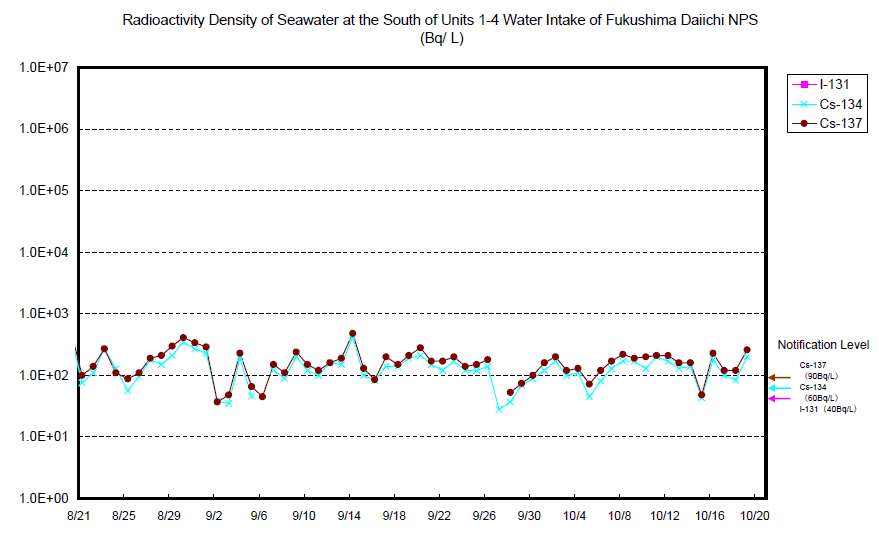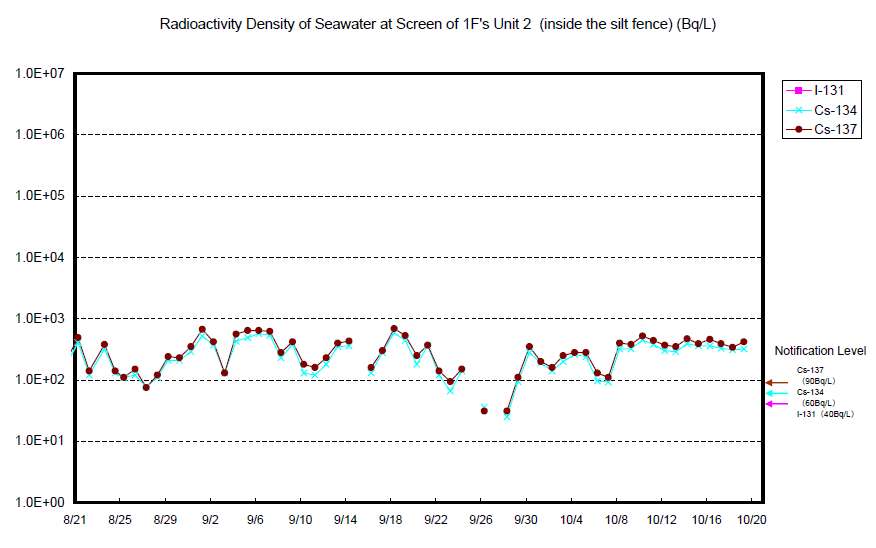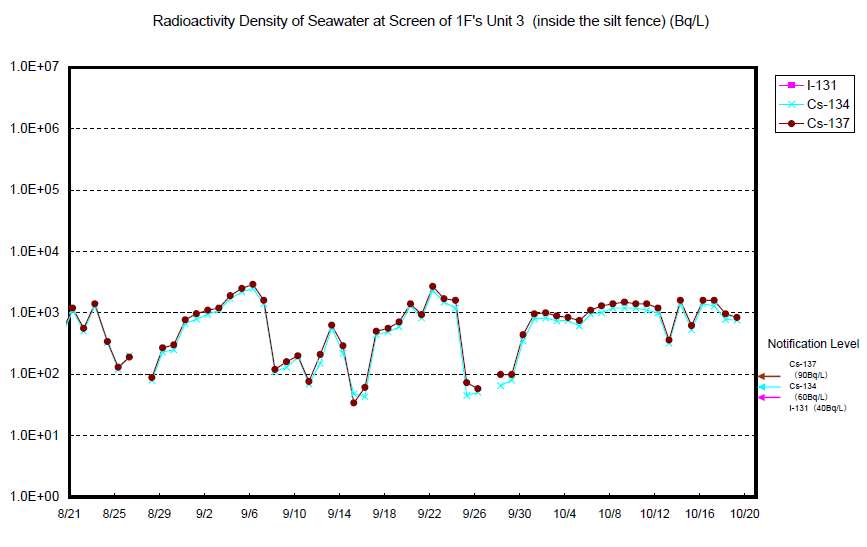A river of groundwater, 450 tons per day, is running through Fukushima Daiichi Units 1-4 according to calculations made by Asahi Shinbun. The water is interacting with water contaminated by the melted down reactor fuel, producing large amounts of highly contaminated water in the basements of the failed reactor buildings. Because the reactor basements are at an elevation near sea level they remains in constant contact with flowing groundwater. TEPCO has used the basements for storing water used to cool the melted down reactor fuel. Some reactor fuel may have melted down to the basement level to continuously interact with ground water. The exact location of the melted fuel assemblies in the failed reactor units has never been made clear by TEPCO.
TEPCO is trying to clean up contaminated water with ion exchange resins, then using it for cooling water, but the decontamination system can't keep up with the large volume of water. TEPCO continues to expand the storage capacity for radioactive water to keep the basements from overflowing, but they are having trouble keeping up after heavy rains.
Meanwhile, cesium levels have stayed above regulatory alert levels in the ocean south of Fukushima. TEPCO's Radiation measurements show a continuous influx of radioactive cesium which is apparently being transported by flowing groundwater. The good news is that short lived radioactive iodine levels have stayed below detectable levels for months, indicating that no recriticality events have occurred.
Does TEPCO have any plan to stop the flow of groundwater into the reactor buildings and turbine buildings, which just adds to the amount of highly contaminated water to be treated and stored? TEPCO is fast running out of storage space, even with cutting down more trees to make room for the storage tanks.Other than spraying the low-contamination, treated water on the premise, the answer is no. No plan, as TEPCO is running out of money that it is willing to spend on Fukushima I Nuke Plant.
He translated the Asahi Shinbun report into English to make it available to a global readership.
原発事故の復旧を目指す東京電力福島第一原発の原子炉建屋やタービン建屋内に、この4カ月間で計約5万トンの地下水が流れ込み、放射能汚染水が4割増えたことが分かった。流入はいまも続き、浄化後の汚染水が増え続けて保管場所が不足する恐れがあるほか、水処理施設の不具合と大雨が重なれば、建屋から汚染水があふれる可能性もある。It has been discovered that the contaminated water has increased by 40% in 4 months inside the reactor buildings and turbine buildings at Fukushima I Nuclear Power Plant, with the inflow of ground water of about 50,000 tonnes. The flow still continues. TEPCO may run out of storage space for the treated, still-contaminated, water. There is also a possibility of the highly contaminated water overflowing from the buildings if a problem at the water treatment facility and a heavy rain coincide.
東京電力の公表データをもとに朝日新聞が試算したところ、水処理施設が本格稼働した6月下旬以降、1~4号機の建屋地下には1日あたり約450トンの地下水が流れ込み続けている。建屋の壁などに損傷部があるためとみられる。
According to the calculation done by Asahi Shinbun based on the data published by TEPCO, about 450 tonnes of ground water per day have been flowing into the buildings of Reactors 1 through 4 since the end of June when the contaminated water treatment facility started the operation. It is considered that there are damages in the walls of the buildings.
Figures released today by TEPCO show a pretty constant (above regulatory limits) level of radioactive cesium isotopes in seawater south of the Fukushima reactors for the past 2 months. Because ocean currents are constantly moving the sea water, these data indicate that contaminated water is continually flowing from the breached reactors to the ocean.
Radioactive Cesium remains above regulatory limits at the ocean intake for units 1-4 south of the Fukushima reactor facility.

Radioactive cesium remains above regulatory limits at the trenches near the damaged reactors.

This Ashai Shinbon report shows the situation may deteriorate as TEPCO runs out of storage capacity for the highly radioactive water in the reactor basements. TEPCO has no plans for stopping the influx of groundwater and no plans for action when the storage capacity for contaminated water is exceeded. A TEPCO representative has admitted they have no prospects for solving the fundamental problem. Radioactive water will continue to flow into the ocean near the damaged reactors for the foreseeable future. Contamination of the ocean could get worse when the storage capacity is exceeded and the radioactive water overflows.
淡水化処理に伴って出る塩分の濃い濃縮廃液は専用のタンクにためられるが、増え続ければタンクを増やす必要がある。現在、毎月2万トン分のタンクを増設しており、タンク置き場を確保するため、東電は原発敷地内の森を伐採している。水を蒸発させることで量を減らす装置があるが、現在は稼働していない。Concentrated, highly saline waste water after the desalination process is stored in the special tanks. As more water is processed, more tanks are needed. TEPCO is installing 20,000 tonnes storage tanks every month. To secure the space for the tanks the company has been cutting down the trees in the plant compound. There is a system to evaporate water to reduce the amount of waste water, but it is not currently used.
原子炉冷却に使った高濃度汚染水がたまるタービン建屋の水位は現在、あふれる恐れがある高さの約1メートル下にあり、大雨が降ってすぐにあふれ出るレベルではないが、水処理装置の不具合が重なれば、循環が滞って水位が一気に上昇する恐れがある。
The water level in the turbine buildings where the highly contaminated water after the reactor cooling accumulates is 1 meter below the level at which there is a danger of overflowing. It is not the level that would cause immediate overflow after a heavy rain. However, if the heavy rain is coupled with a trouble at the water treatment system that hampers the water circulation, the water level could rise very rapidly.
水処理施設の能力は1日1400トン。東電は、施設が順調に稼働しており、循環注水冷却が安定していることを強調するが、処理すべき水が増えている現状が続けば、施設に過分な負荷がかかり、不具合につながりかねない。
The treatment capacity of the water treatment facility is 1,400 tonnes per day. TEPCO emphasizes that the facility is running smoothly and the circulatory water injection system is stable. However, if the current situation continues where groundwater keeps coming into the buildings that needs to be treated, the water treatment facility will be taxed with excess load, which may cause a problem.
地下水流入を完全に止めるのは難しく、東電は対策工事を計画していない。汚染水がたまり続けることに対して、東電の原子力・立地本部の松本純一本部長代理は「建屋の地下部分を使わずに水を循環させる、よりコンパクトな水処理にしないと、流入する地下水の処理が必要な状況からぬけられない」としているが、根本解決のめどは立っていない。
It is difficult to stop the inflow of groundwater completely, and TEPCO is not planning any countermeasure construction. Regarding the continued inflow of groundwater into the buildings, TEPCO's Junichi Matsumoto says, "We have to come up with a more compact water treatment system in which we can circulate water without using the basements of the buildings. Otherwise we would be stuck in a situation where we have to treat the groundwater coming into the basements." However, there is no prospect of fundamentally solving the problem.
